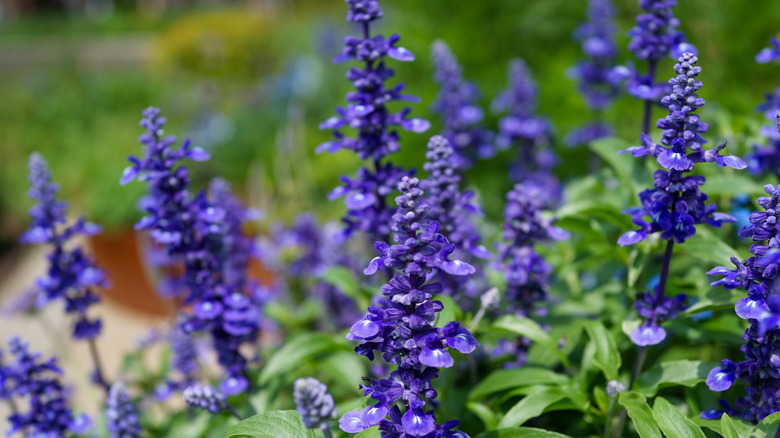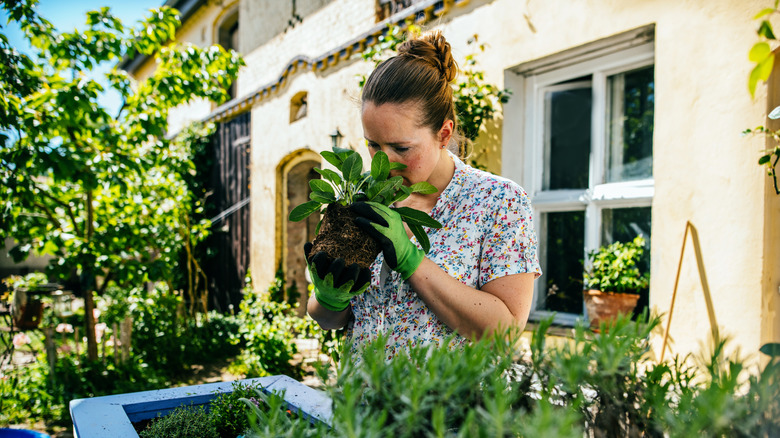Sage Or Salvia? What's The Difference, And Which Variety Is Right For You?
One is a staple in the kitchen, the other a cornerstone of flower gardens nationwide. But whether you call it sage or salvia, the truth is this: You're talking about the same plant. Salvia, a versatile genus in the Lamiaceae (mint) family, has nearly 1,000 distinctly cultivated varieties offering culinary or ornamental value (and sometimes both). Although "sage" may bring up memories of a weekend roast, the aromatic herb flavoring your gravy is actually the same plant that blooms vibrantly in the flower garden, attracting bees, butterflies, and hummingbirds. Understanding the differences between culinary and ornamental salvias can help you choose the right variety for your garden.
The genus name Salvia shares its Latin root with the word "salvation," a nod to the plant's long-documented healing properties. Over time, salvia's common name, sage, became popular for varieties used in most culinary, medicinal, or spiritual applications — everything from ancient Roman ceremonies to Michelin-star restaurants — while salvia remained indicative of ornamental or inedible varieties. But today, the names are practically interchangeable. The main difference is this: culinary sage is grown for its aromatic foliage and not often left to flower, while ornamental salvia is coveted for its long-lasting blooms.
When choosing between culinary sage or ornamental salvia, it's important to think about your garden's purpose. If you're creating an herb garden on your patio filled with rosemary and thyme, then a culinary sage such as common garden sage will fit right in. But if you're designing a perennial flower garden to attract more pollinators, ornamental salvias like Mexican bush sage may better suit your needs. To help you decide, here's a breakdown of several popular varieties.
Choosing the right culinary sage
While many salvias are technically edible, a few have been cultivated primarily for culinary use. But you're most likely to find common garden sage (Salvia officinalis) at your local nursery in spring. Hardy in USDA Hardiness Zones 4 through 10, common sage has many uses in the home and garden. The characteristically fuzzy, silver-toned leaves grow in tight florets and are easy to harvest and use fresh or dry. There are also dozens of cultivars to choose from, including the visually striking 'Tri-color' variety and the large-leaved 'Berggarten' cultivar.
Surprisingly, though, you're not likely to find common garden sage with the dried herbs in the grocery store. To replicate these store-bought herbs, look for Greek sage (Salvia fruticosa). This small-leaved, heat-loving variety is only hardy in zones 8 through 11, so it's less likely to survive a frosty winter. White sage (Salvia apiana), a slower-growing variety hardy to zone 7, is often prized for its spiritual and medicinal properties — you're more likely to see this herb turned into incense than used in the kitchen.
Some sage varieties, like pineapple sage (Salvia elegans), bridge the gap between edible and ornamental with a combination of aromatic foliage and vivid blooms. Hardy to zone 8, pineapple sage is coveted in the kitchen for its bright, fruity aroma and delicate, yellow-green foliage. When left to flower, however, its vibrant, flame-red flowers are a favorite of butterflies and hummingbirds.
Ornamental salvias that pollinators love
If you're looking for flowers that attract hummingbirds and other pollinators, ornamental salvias will surely do the trick. While some may still be edible, these varieties are prized for their blooms rather than their foliage. Aptly named hummingbird sage (Salvia spathacea) is a low-growing and quick-spreading shrub hardy in zones 8 through 11. Its prolific magenta blossoms, which are narrow and tubular, are easily accessed by insects with long proboscises, making this an ideal nectar source for hummingbirds and butterflies.
To extend the pollinator feast through fall, plant autumn sage (Salvia greggii) nearby. This late-blooming variety native to Texas is extremely tolerant of the heat in both dry and humid areas, although it's only considered hardy in zones 6 through 9. The mounding shrub can reach 2 to 3 feet tall and is covered with thin stalks of overtly lipped, bright red buds. Planting this perennial among other spring-flowering varieties is a great way to extend your garden's bloom time.
Another fall favorite, Mexican bush sage (Salvia leucantha) is an end-of-season dazzler. Native to Mexico and hardy in zones 7 through 10, this perennial shrub spends most of the summer bushing out into a dense, 3-foot-tall shrub of fuzzy foliage. But as other flowers begin to wane, Mexican bush sage erupts with tall spires covered in violet blooms; a showstopping ending to your growing season.


